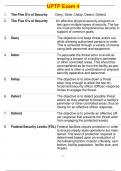Tentamen (uitwerkingen)
UPTP Exam 4
- Vak
- Instelling
UPTP Exam 4 1. The Five D's of Security Deny, Deter, Delay, Detect, Defend 2. The Five D's of Security An effective physical security program re- lies upon multiple layers of security. The lay- ers must provide comprehensive security in support of common goals. 3. Deny The objective is to kee...
[Meer zien]




